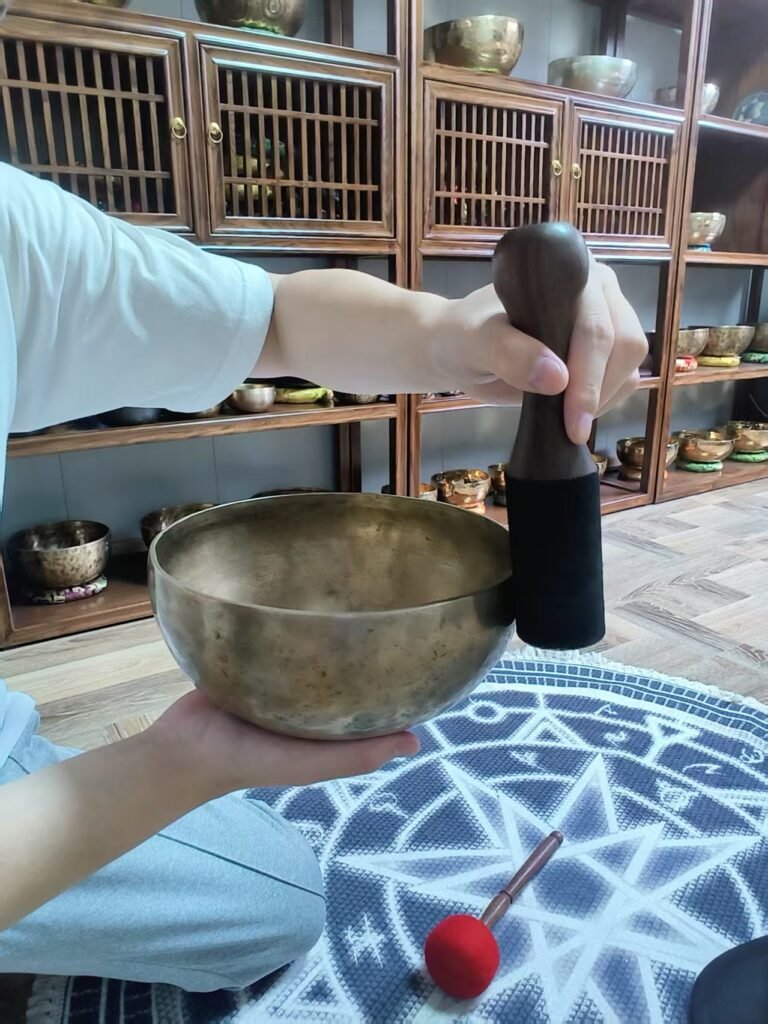

In our increasingly connected and fast-paced world, quality sleep has become an elusive treasure for millions of people seeking rest and restoration. As traditional pharmaceutical approaches to sleep difficulties raise concerns about dependency and side effects, many individuals are turning toward ancient wisdom and natural healing modalities to reclaim their ability to sleep peacefully and wake refreshed.
Among the time-tested tools emerging from this renaissance of natural healing practices, singing bowls have captured particular attention for their potential to facilitate deeper relaxation and improved sleep quality. These sacred instruments, with their rich history in Tibetan and Himalayan spiritual traditions, offer a gentle yet powerful approach to addressing the stress, anxiety, and mental overstimulation that often interfere with our natural sleep processes.
The relationship between sound and sleep represents a fascinating intersection of ancient wisdom and modern neuroscience, where traditional understanding of vibrational healing meets contemporary research into the neurological mechanisms underlying relaxation and sleep induction. As we explore this connection, we discover how the unique acoustic properties of singing bowls may offer a natural pathway to the restorative sleep our bodies and minds desperately need.
Understanding whether and how singing bowls can enhance sleep quality requires examining both the scientific foundations of sound’s effect on consciousness and the practical applications that have helped countless individuals establish healthier sleep patterns while honoring the contemplative traditions from which these practices emerge.

The human brain operates through complex electrical patterns that can be influenced by external acoustic stimuli, creating opportunities for sound-based interventions to positively impact sleep-related neural activity. Singing bowl frequencies typically range from 110 Hz to 660 Hz, corresponding to brain wave patterns associated with relaxation, meditation, and various stages of sleep, suggesting natural compatibility between these instruments and the neural states necessary for quality rest.
Brain wave entrainment represents one of the primary mechanisms through which singing bowls may influence sleep quality, as the sustained, resonant tones can guide neural oscillations toward frequencies associated with deep relaxation and sleep preparation. Alpha waves (8-12 Hz), associated with relaxed awareness, and theta waves (4-8 Hz), linked to deep meditation and early sleep stages, can be enhanced through exposure to appropriate acoustic frequencies that encourage the brain to synchronize with external rhythmic patterns.
The default mode network, a collection of brain regions active during rest and introspection, appears to quiet in response to focused attention on sustained acoustic stimuli like singing bowl tones. This neurological shift away from the self-referential thinking patterns that often keep us awake can facilitate the mental transition necessary for sleep onset while reducing the rumination and worry that frequently interfere with rest.
Research into neural oscillations suggests that the complex harmonic structures produced by singing bowls may simultaneously influence multiple brain wave frequencies, creating a comprehensive acoustic environment that supports the natural progression from wakefulness through various sleep stages. This multi-frequency influence may explain why many practitioners report not only faster sleep onset but also improved sleep depth and quality throughout the night.
The autonomic nervous system, which controls involuntary bodily functions including heart rate, breathing, and digestion, plays a crucial role in sleep quality and can be significantly influenced by acoustic interventions like singing bowl practice. The parasympathetic nervous system, responsible for rest and restoration, becomes activated through exposure to calming sounds that signal safety and relaxation to the body’s stress response mechanisms.
Heart rate variability, a measure of the variation in time between heartbeats, typically improves during parasympathetic activation and serves as an indicator of the body’s readiness for sleep and recovery. Singing bowl sessions often produce measurable increases in heart rate variability while simultaneously reducing heart rate and blood pressure, creating physiological conditions conducive to deep rest and sleep.
The stress hormone cortisol, which can interfere with sleep when elevated, often decreases following singing bowl practice as the body’s stress response systems recognize the acoustic environment as safe and non-threatening. This hormonal shift, combined with increased production of relaxation-promoting neurotransmitters like GABA and serotonin, creates internal conditions that naturally support sleep onset and maintenance.
Breathing patterns, closely linked to both autonomic nervous system function and sleep quality, tend to deepen and slow during singing bowl sessions as the sustained tones encourage longer exhalations that activate the parasympathetic nervous system. This natural breathing adjustment not only promotes immediate relaxation but also helps establish the slower respiratory rhythms characteristic of quality sleep.
Attention redirection represents one of the most immediate psychological benefits of singing bowl practice for sleep enhancement, as the sustained, evolving tones provide a focal point that draws awareness away from the daily concerns, planning, and worry that often prevent sleep onset. This attention anchor allows the mind to disengage from problem-solving mode and enter the receptive state necessary for sleep.
The practice of listening to singing bowls cultivates present-moment awareness that interrupts the future-focused anxiety and past-focused rumination patterns that commonly interfere with sleep. By anchoring attention in immediate auditory experience, practitioners develop skills for returning to the present moment when mental activity threatens to prevent rest.
Singing bowls may help establish psychological safety and security through their association with spiritual practice, meditation, and healing traditions that emphasize peace and protection. This sense of being held by ancient wisdom and healing intention can provide comfort to those whose sleep difficulties stem from feelings of vulnerability, uncertainty, or lack of control in their lives.
The ritual aspect of singing bowl practice creates beneficial psychological conditioning where the sound becomes associated with relaxation and sleep preparation, eventually triggering relaxation responses through learned association. This classical conditioning effect can strengthen over time, making the singing bowl an increasingly effective tool for sleep induction as the practice becomes established.
Creating an effective pre-sleep singing bowl practice requires careful attention to timing, environment, and personal needs to establish a consistent routine that signals to both mind and body that sleep preparation has begun. The optimal timing typically involves beginning the practice 30-60 minutes before desired sleep time, allowing sufficient space for the relaxation response to develop while avoiding the risk of becoming too alert through overstimulation.
Environmental preparation forms the foundation of effective singing bowl sleep practice, requiring attention to lighting, temperature, comfort, and the elimination of potential distractions that could interfere with the relaxation process. Soft, warm lighting helps maintain the body’s natural circadian rhythms while creating an atmosphere conducive to introspection and relaxation, while comfortable room temperature supports the natural cooling that facilitates sleep onset.
The physical preparation process might include changing into comfortable sleepwear, completing personal hygiene routines, and arranging the sleeping environment to eliminate potential disruptions during the night. This practical preparation, combined with the mental preparation of releasing the day’s concerns and setting intentions for restful sleep, creates optimal conditions for the singing bowl practice to be most effective.
Personal ritual elements such as gratitude reflection, gentle stretching, or brief meditation can enhance the effectiveness of singing bowl practice while honoring individual preferences and spiritual orientations. These personalized additions help create a unique bedtime ceremony that becomes increasingly powerful through consistent repetition and mindful attention.

Effective singing bowl technique for sleep enhancement emphasizes gentleness, consistency, and gradual progression from more active playing to increasingly subtle and sparse sounds that mirror the natural transition from wakefulness to sleep. Beginning with slightly more audible tones helps establish attention and engagement before gradually reducing volume and frequency to support the deepening relaxation process.
The striking technique involves using a soft mallet to create clear, bell-like tones that provide immediate acoustic impact while maintaining the gentle quality necessary for bedtime practice. Strikes should be spaced generously to allow each tone to develop fully and begin its natural decay before the next sound is produced, creating spacious acoustic experiences that support mental quieting.
Rim singing, created by moving a wooden or suede-covered mallet around the bowl’s edge with steady pressure, produces sustained tones that can continue for extended periods with proper technique. This continuous sound approach provides consistent acoustic anchoring for attention while requiring minimal physical movement that might interfere with increasing physical relaxation.
The progression from more frequent sounds to increasing silence mirrors the natural transition toward sleep while maintaining just enough acoustic presence to support continued attention and prevent the mind from wandering into activating thoughts. This gradual reduction in stimulation helps guide consciousness through the liminal space between waking and sleeping without abrupt changes that might disrupt the relaxation process.
Individual sensitivity to sound varies significantly among practitioners, requiring careful attention to personal responses and preferences when developing an effective singing bowl sleep practice. Some individuals may be particularly sensitive to higher frequencies, requiring bowls with deeper, more mellow tones, while others may find clarity and precision more conducive to relaxation than warmth and resonance.
Sleep pattern analysis can inform the timing and structure of singing bowl practice, with individuals who struggle primarily with sleep onset benefiting from longer, more comprehensive sessions, while those experiencing sleep maintenance difficulties might prefer shorter, gentler practices that can be easily repeated if awakening occurs during the night.
Integration with existing bedtime routines requires thoughtful consideration of how singing bowl practice can complement rather than complicate established sleep preparation activities. The practice should enhance rather than replace beneficial routines while addressing specific areas where additional support for relaxation and mental quieting would be most valuable.
Adaptation over time allows practitioners to refine their approach based on experience and changing needs, recognizing that effective sleep support may require different approaches during periods of stress, seasonal changes, or life transitions. This flexibility ensures that the practice remains relevant and beneficial as circumstances evolve while maintaining the core benefits of acoustic relaxation support.
Choosing an appropriate singing bowl for sleep enhancement requires considering acoustic qualities that support relaxation and peace rather than stimulation or activation. Lower-pitched bowls with rich, warm tones generally prove more suitable for bedtime use than higher-pitched bowls that might feel too bright or alerting when the goal is mental quieting and physical relaxation.
Size considerations affect both the acoustic properties and practical aspects of bedtime singing bowl use, with medium to larger bowls typically producing the deeper, more sustained tones conducive to sleep while remaining manageable for bedside use. Very large bowls may prove impractical for bedroom use, while very small bowls might lack the depth and sustain beneficial for extended relaxation sessions.
Quality factors including construction materials, craftsmanship, and acoustic consistency significantly impact the effectiveness of singing bowl practice for sleep enhancement. Hand-forged bowls often possess more complex harmonic content and longer sustain than machine-made alternatives, though individual assessment of sound quality and personal response remains more important than production method alone.
Budget considerations need not prevent effective singing bowl practice for sleep, as many affordable options can provide excellent acoustic support for relaxation and rest. Beginning practitioners might consider starting with a moderate investment to establish the practice before potentially upgrading to higher-quality instruments as experience and commitment develop.
Creating an optimal acoustic environment for bedtime singing bowl practice requires attention to room acoustics, neighboring spaces, and potential sound transmission that could disturb others or create anxiety about causing disruption. Soft furnishings, carpeting, and curtains can help create more intimate acoustic spaces that contain and warm the singing bowl’s sound while reducing reflections that might feel harsh or alerting.
Positioning considerations include placing the singing bowl within easy reach of the bed while ensuring safe, stable placement that prevents accidental contact or disturbance during the night. A small table, shelf, or dedicated surface near the head of the bed often provides ideal accessibility while maintaining appropriate acoustic distance for comfortable listening.
Lighting coordination supports the circadian rhythm benefits of bedtime singing bowl practice by maintaining dim, warm illumination that doesn’t interfere with natural melatonin production while providing sufficient visibility for safe bowl handling. Candles, salt lamps, or dimmed bedside lights can create appropriate atmospheric lighting that enhances rather than detracts from the relaxation experience.
Temperature and comfort optimization ensures that physical discomfort doesn’t interfere with the relaxation benefits of singing bowl practice, requiring attention to room temperature, bedding comfort, and clothing that supports both the practice session and subsequent sleep. The environment should facilitate an easy transition from active listening to passive rest without requiring adjustments that might disrupt the relaxation process.
Hearing protection becomes relevant for extended or frequent singing bowl practice, particularly for individuals with existing hearing sensitivities or those using larger bowls capable of producing significant volume. Maintaining moderate volume levels and limiting session duration helps prevent acoustic overexposure while maintaining therapeutic benefits.
Emotional response management may be necessary for some practitioners, as deep relaxation and the altered consciousness states facilitated by singing bowl practice can sometimes bring suppressed emotions or memories to the surface. Having strategies for gentle emotional processing and professional support resources available can help practitioners navigate any unexpected psychological responses safely.
Physical safety considerations include proper bowl placement and handling to prevent drops, breaks, or injuries during drowsy or relaxed states. Using stable surfaces, appropriate lighting, and mindful handling techniques helps ensure that the practice remains safe and sustainable over time.
Special population considerations affect the appropriateness of singing bowl practice for certain individuals, including pregnant women, children, individuals with certain medical conditions, and those taking medications that might affect hearing or balance. Consulting with healthcare providers when questions arise ensures that singing bowl practice supports rather than interferes with overall health and wellbeing.
Singing bowl practice for sleep enhancement offers genuine benefits for many individuals while requiring realistic expectations about the timeline and nature of improvements. Most practitioners notice some immediate relaxation benefits, while more significant changes in sleep quality and consistency typically develop over weeks or months of consistent practice as the nervous system adapts and beneficial conditioning strengthens.
Individual variation in response means that some people may experience dramatic improvements in sleep quality relatively quickly, while others may notice more subtle changes that accumulate over time. Factors including overall health, stress levels, sleep environment, and consistency of practice all influence outcomes, making it important to approach singing bowl sleep practice as one component of comprehensive sleep hygiene rather than a standalone solution.
The benefits of singing bowl practice often extend beyond sleep improvement to include reduced anxiety, enhanced relaxation skills, and greater overall sense of wellbeing that supports multiple aspects of health and life satisfaction. These broader benefits can make the practice valuable even when sleep improvements are modest, contributing to overall quality of life in ways that support better sleep indirectly.
Success indicators might include falling asleep more easily, experiencing fewer night wakings, feeling more rested upon awakening, or simply enjoying the bedtime routine more due to the peaceful, nurturing quality of singing bowl practice. Recognizing and appreciating these various forms of benefit helps maintain motivation and appreciation for the practice regardless of specific sleep outcomes.
Establishing sustainable singing bowl practice for sleep requires balancing consistency with flexibility, maintaining regular practice while adapting to changing schedules, stress levels, and life circumstances. Building the practice gradually and allowing for occasional breaks or modifications helps prevent the practice from becoming another source of pressure or obligation.
Skill development in singing bowl technique can enhance the effectiveness and enjoyment of the practice over time, with opportunities to explore different playing approaches, acquire additional bowls with complementary tones, or integrate other relaxation techniques that support the acoustic foundation provided by the bowls.
Community and learning resources including local meditation groups, online communities, workshops, and instructional materials can provide ongoing support and inspiration for maintaining and deepening singing bowl practice. Connection with others who share interest in sound healing and natural sleep support can provide encouragement and practical guidance for addressing challenges that arise.
Documentation of personal experience through sleep diaries, practice notes, or audio recordings can help track progress, identify patterns, and refine approaches based on what proves most effective for individual needs and preferences. This personal research approach honors the individual nature of sleep and healing while building confidence in the practice’s benefits.
The integration of singing bowls into sleep enhancement represents a gentle return to humanity’s ancient understanding of sound’s healing power, offering a natural complement to modern sleep science and conventional sleep hygiene practices. Whether used as a primary approach for mild sleep difficulties or as supportive practice alongside other interventions, singing bowls provide a peaceful, sustainable tool for nurturing the deep rest our bodies and minds require for optimal health and wellbeing.
For those drawn to explore this ancient practice in service of better sleep, the journey begins simply with acquiring a quality bowl, creating a peaceful bedtime environment, and approaching the practice with patience, curiosity, and appreciation for the profound healing potential held within these seemingly simple instruments. As the gentle sounds guide consciousness toward rest and the nervous system learns to recognize these acoustic signals as invitations to peace, many practitioners discover that singing bowls offer not just better sleep, but a deeper relationship with stillness, presence, and the natural rhythms that support human flourishing.

